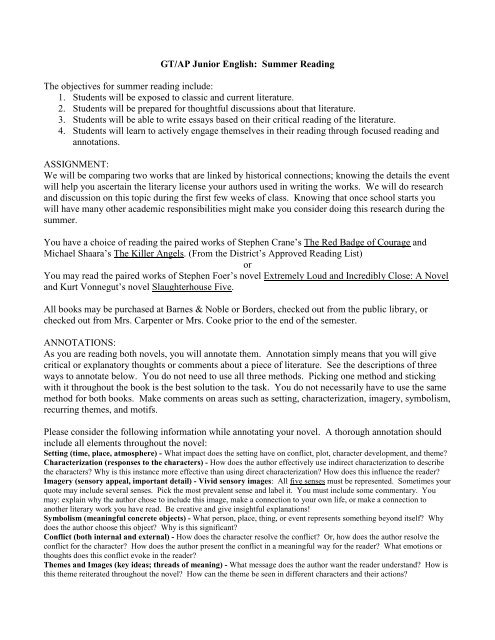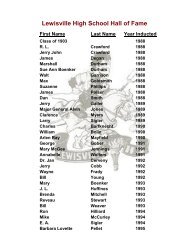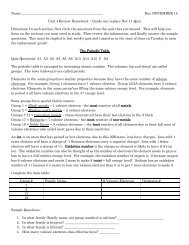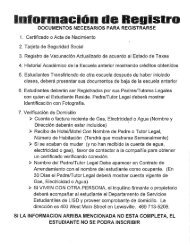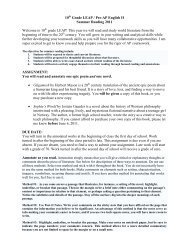GT/AP Junior English: Summer Reading
GT/AP Junior English: Summer Reading
GT/AP Junior English: Summer Reading
You also want an ePaper? Increase the reach of your titles
YUMPU automatically turns print PDFs into web optimized ePapers that Google loves.
<strong>GT</strong>/<strong>AP</strong> <strong>Junior</strong> <strong>English</strong>: <strong>Summer</strong> <strong>Reading</strong><br />
The objectives for summer reading include:<br />
1. Students will be exposed to classic and current literature.<br />
2. Students will be prepared for thoughtful discussions about that literature.<br />
3. Students will be able to write essays based on their critical reading of the literature.<br />
4. Students will learn to actively engage themselves in their reading through focused reading and<br />
annotations.<br />
ASSIGNMENT:<br />
We will be comparing two works that are linked by historical connections; knowing the details the event<br />
will help you ascertain the literary license your authors used in writing the works. We will do research<br />
and discussion on this topic during the first few weeks of class. Knowing that once school starts you<br />
will have many other academic responsibilities might make you consider doing this research during the<br />
summer.<br />
You have a choice of reading the paired works of Stephen Crane’s The Red Badge of Courage and<br />
Michael Shaara’s The Killer Angels. (From the District’s Approved <strong>Reading</strong> List)<br />
or<br />
You may read the paired works of Stephen Foer’s novel Extremely Loud and Incredibly Close: A Novel<br />
and Kurt Vonnegut’s novel Slaughterhouse Five.<br />
All books may be purchased at Barnes & Noble or Borders, checked out from the public library, or<br />
checked out from Mrs. Carpenter or Mrs. Cooke prior to the end of the semester.<br />
ANNOTATIONS:<br />
As you are reading both novels, you will annotate them. Annotation simply means that you will give<br />
critical or explanatory thoughts or comments about a piece of literature. See the descriptions of three<br />
ways to annotate below. You do not need to use all three methods. Picking one method and sticking<br />
with it throughout the book is the best solution to the task. You do not necessarily have to use the same<br />
method for both books. Make comments on areas such as setting, characterization, imagery, symbolism,<br />
recurring themes, and motifs.<br />
Please consider the following information while annotating your novel. A thorough annotation should<br />
include all elements throughout the novel:<br />
Setting (time, place, atmosphere) - What impact does the setting have on conflict, plot, character development, and theme<br />
Characterization (responses to the characters) - How does the author effectively use indirect characterization to describe<br />
the characters Why is this instance more effective than using direct characterization How does this influence the reader<br />
Imagery (sensory appeal, important detail) - Vivid sensory images: All five senses must be represented. Sometimes your<br />
quote may include several senses. Pick the most prevalent sense and label it. You must include some commentary. You<br />
may: explain why the author chose to include this image, make a connection to your own life, or make a connection to<br />
another literary work you have read. Be creative and give insightful explanations!<br />
Symbolism (meaningful concrete objects) - What person, place, thing, or event represents something beyond itself Why<br />
does the author choose this object Why is this significant<br />
Conflict (both internal and external) - How does the character resolve the conflict Or, how does the author resolve the<br />
conflict for the character How does the author present the conflict in a meaningful way for the reader What emotions or<br />
thoughts does this conflict evoke in the reader<br />
Themes and Images (key ideas; threads of meaning) - What message does the author want the reader understand How is<br />
this theme reiterated throughout the novel How can the theme be seen in different characters and their actions
NOVEL DESCRIPTIONS:<br />
The Killer Angels (1974) is a historical novel by Michael Shaara that was awarded the Pulitzer Prize for Fiction in 1975. The<br />
book tells the story of four days of the Battle of Gettysburg in the American Civil War: June 29, 1863, as the troops of both<br />
the Union and the Confederacy move into battle around the town of Gettysburg, Pennsylvania, and July 1, July 2, and July 3,<br />
when the battle was fought. The story is character driven and told from the perspective of various protagonists. Beginning<br />
with the famous section about Longstreet's spy Harrison gathering information about the movements and positions of the<br />
Federals, each day is told primarily from the perspectives of commanders of the two armies, including Robert E. Lee and<br />
James Longstreet for the Confederacy, and Joshua Lawrence Chamberlain and John Buford for the Union. Most chapters<br />
describe the emotion-laden decisions of these officers as they went into battle. Maps depicting the positioning of the troops as<br />
they went to battle, as they advanced, add to the sense of authenticity as decisions are made to advance and retreat with the<br />
armies. The author also uses the story of Gettysburg, the largest battle in the history of North America, to relate the causes of<br />
the Civil War and the motivations that led old friends to face each other on the battlefield.<br />
Wikipedia<br />
The Red Badge of Courage is a 1895 war novel by American author Stephen Crane. It is considered one of the most<br />
influential works in American literature. The novel, in which a young recruit in the American Civil War is faced by the<br />
cruelty of war, made Crane an international success. Although he was born after the war and had not at the time experienced<br />
battle firsthand, the novel is considered an example of Realism. During an unnamed conflict of the American Civil War, 18-<br />
year-old private Henry Fleming deserts his battalion, considering the battle to be a lost cause. Escaping into a nearby forest,<br />
he finds a group of injured men. One member of the group, the "Tattered Soldier", asks Henry (who is often referred to as<br />
"The Youth") where he is wounded. Henry, embarrassed that he does not have any wounds, leaves the group and wanders<br />
through the forest. He ultimately decides that running was the best thing, and that he is a small part of the army that is<br />
responsible for saving himself. Henry later learns that his battalion has won the battle, and feels incredibly guilty. As a result,<br />
he returns to his battalion. He is involved in a dispute with a cannon operator, who hits Henry in the head when the boy<br />
refuses to let go of the gunner's arm. When Henry returns to camp, the other soldiers believe his head injury to be caused by a<br />
bullet grazing him in battle. The next morning Henry goes into battle for the third time. While looking for a stream from<br />
which to get water, he discovers from the commanding officer that his regiment has a lackluster reputation. The officer<br />
speaks casually about sacrificing Henry's regiment because they are nothing more than "mule drivers" and "mud diggers".<br />
With no regiments to spare, the general orders his men forward. In the final battle, Henry becomes one of the best fighters in<br />
his battalion as well as the flag bearer, finally proving his courage as a man. Wikipedia<br />
Extremely Loud and Incredibly Close is a 2005 novel by New York writer Jonathan Safran Foer. It was one of the first<br />
novels to deal with the terrorist attacks of September 11, 2001. The book is an example of an emerging school of<br />
contemporary postmodernism which challenges the technical limitations of the novel to create a more immersive work. Oskar<br />
Schell is not your average nine-year-old. A budding inventor, he spends his time imagining wonderful creations. He also<br />
collects random photographs for his scrapbook and sends letters to scientists. When his father dies in the World Trade Center<br />
collapse, Oskar shifts his boundless energy to a quest for answers. He finds a key hidden in his father's things that doesn't fit<br />
any lock in their New York City apartment; its container is labeled "Black." Using flawless kid logic, Oskar sets out to speak<br />
to everyone in New York City with the last name of Black. A retired journalist who keeps a card catalog with entries for<br />
everyone he's ever met is just one of the colorful characters the boy meets. Foer takes a dark subject and works in offbeat<br />
humor with puns and wordplay. The work pushes further with the inclusion of photographs, illustrations, and mild<br />
experiments in typography reminiscent of Kurt Vonnegut's works. The humor works as a deceptive, glitzy cover for a fairly<br />
serious tale about loss and recovery. For balance, Foer includes the subplot of Oskar's grandfather, who survived the World<br />
War II bombing of Dresden. Although this story is not quite as evocative as Oskar's, it does carry forward and connect firmly<br />
to the rest of the novel. The two stories finally intersect in a powerful conclusion that will make even the most jaded hearts<br />
fall. —Matthew L. Moffett, Northern Virginia Community College, Annandale, VA.<br />
Slaughterhouse-Five, or The Children's Crusade: A Duty-Dance With Death (1969), by Kurt Vonnegut, is a post-modern<br />
anti-war science fiction novel dealing with a soldier's (Billy Pilgrim) experiences during World War II and his journeys with<br />
time travel. Billy Pilgrim is the son of an American barber. He serves as a chaplain’s assistant in World War II, is captured<br />
by the Germans, and he survives the largest massacre in European history – the fire bombing of Dresden. After the war Billy<br />
makes a great deal of money as an optometrist, and on his wedding night he is kidnapped by a flying saucer from the planet<br />
Tralfamadore. So begins a modern classic by a master storyteller – who relies upon his own experiences as one of the few<br />
survivors of the bombing of Dresden.


